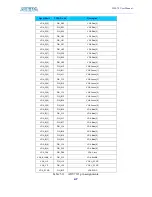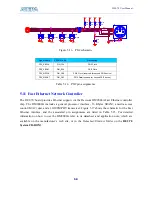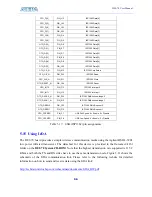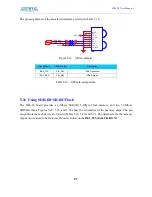
DE2-70 User Manual
45
5.7
Using VGA
The DE2-70 board includes a 16-pin D-SUB connector for VGA output. The VGA synchronization
signals are provided directly from the Cyclone II FPGA, and the Analog Devices ADV7123 triple
10-bit high-speed video DAC is used to produce the analog data signals (red, green, and blue). The
associated schematic is given in Figure 5.12 and can support resolutions of up to 1600 x 1200 pixels,
at 100 MHz.
RSET
VGA_G9
VGA_G0
VGA_G8
VGA_G7
VGA_G6
VGA_G5
VGA_G4
VGA_G3
VGA_G2
VGA_G1
V
G
A
_R
0
V
G
A
_R
1
V
G
A
_R
2
V
G
A
_R
3
V
G
A
_R
4
V
G
A
_R
5
V
G
A
_R
6
V
G
A
_R
7
V
G
A
_R
8
V
G
A
_B
9
V
G
A
_B
8
V
G
A
_B
7
V
G
A
_B
6
V
G
A
_B
5
V
G
A
_B
4
V
G
A
_B
3
V
G
A
_B
2
V
G
A
_B
1
V
G
A
_B
0
V
G
A
_R
9
VGA_B
VGA_R
VGA_G
VGA_BLANK_n
VGA_R[0..9]
VGA_G[0..9]
VGA_B[0..9]
VGA_SYNC_n
V
G
A
_C
LO
C
K
VGA_HS
VGA_VS
VGA_VCC33
VGA_VCC33
VGA_VCC33
R82
75
R82
75
10
11
6
1
5
15
J7
VGA
10
11
6
1
5
15
J7
VGA
5
9
4
8
3
7
2
6
1
17
16
10
11
12
13
14
15
R83
75
R83
75
R84
75
R84
75
BC49 0.1u
BC49 0.1u
BC48
0.1u
BC48
0.1u
BC47
0.1u
BC47
0.1u
R81
560
R81
560
R85
47
R85
47
R86
47
R86
47
U10
ADV7123
U10
ADV7123
G6
7
SYNC
12
G1
2
G2
3
B
7
21
B
8
22
B
9
23
C
LO
C
K
24
GND
25
GND
26
IOB
27
IOB
28
B
3
17
B
4
18
B
5
19
B
6
20
B
2
16
B
1
15
B
0
14
V
A
A
13
G0
1
G3
4
BLANK
11
G9
10
G4
5
G5
6
G7
8
G8
9
VAA
29
VAA
30
IOG
31
IOG
32
IOR
33
IOR
34
COMP
35
VREF
36
R
S
E
T
37
P
S
A
V
E
38
R
0
39
R
1
40
R
2
41
R
3
42
R
4
43
R
5
44
R
6
45
R
7
46
R
8
47
R
9
48
R80
4.7K
R80
4.7K
Figure 5.12. VGA circuit schematic.
The timing specification for VGA synchronization and RGB (red, green, blue) data can be found on
various educational web sites (for example, search for “VGA signal timing”). Figure 5.13 illustrates
the basic timing requirements for each row (horizontal) that is displayed on a VGA monitor. An
active-low pulse of specific duration (time
a
in the figure) is applied to the horizontal
synchronization (
hsync
) input of the monitor, which signifies the end of one row of data and the
start of the next. The data (RGB) inputs on the monitor must be off (driven to 0 V) for a time period
called the
back porch
(
b
) after the
hsync
pulse occurs, which is followed by the display interval (
c
).
During the data display interval the RGB data drives each pixel in turn across the row being
displayed. Finally, there is a time period called the
front porch
(
d
) where the RGB signals must
again be off before the next
hsync
pulse can occur. The timing of the vertical synchronization (
vsync
)
is the same as shown in Figure 5.13, except that a
vsync
pulse signifies the end of one frame and the
start of the next, and the data refers to the set of rows in the frame (horizontal timing). Table 5.9 and
5.10 show, for different resolutions, the durations of time periods
a
,
b
,
c
, and
d
for both horizontal
and vertical timing.
Detailed information for using the ADV7123 video DAC is available in its datasheet, which can be














































